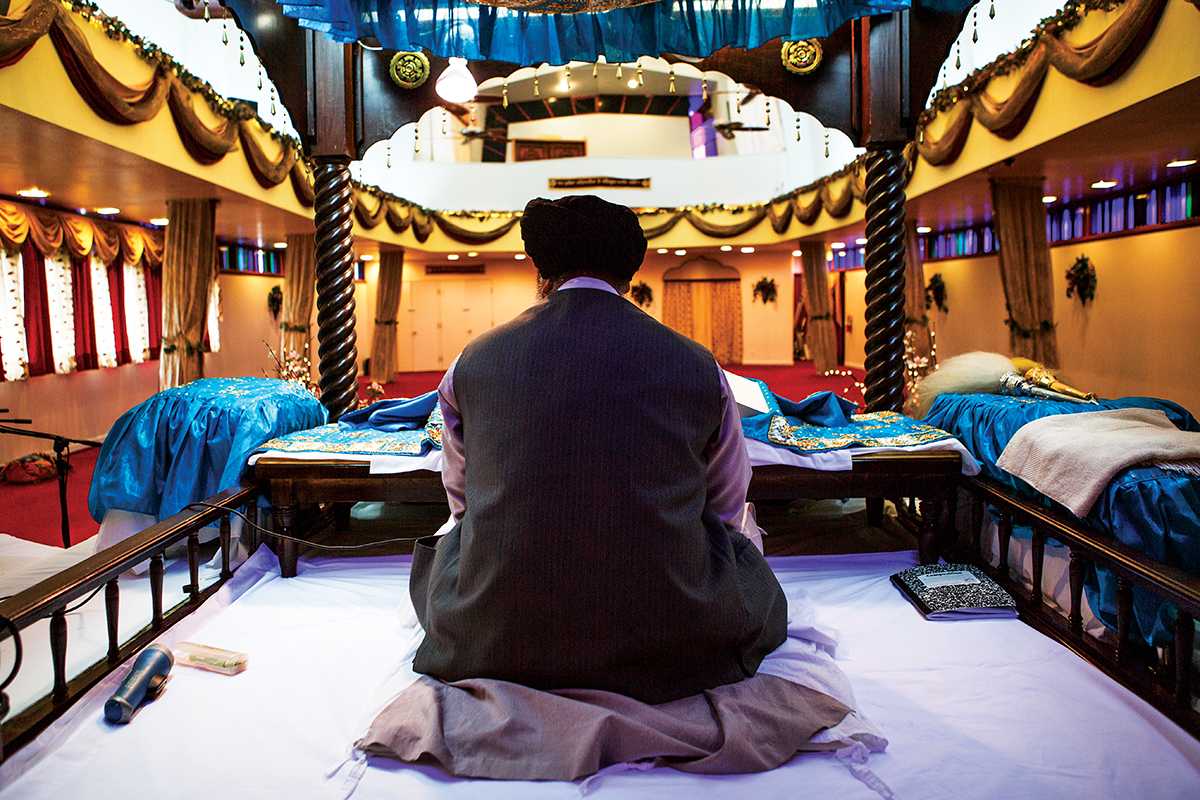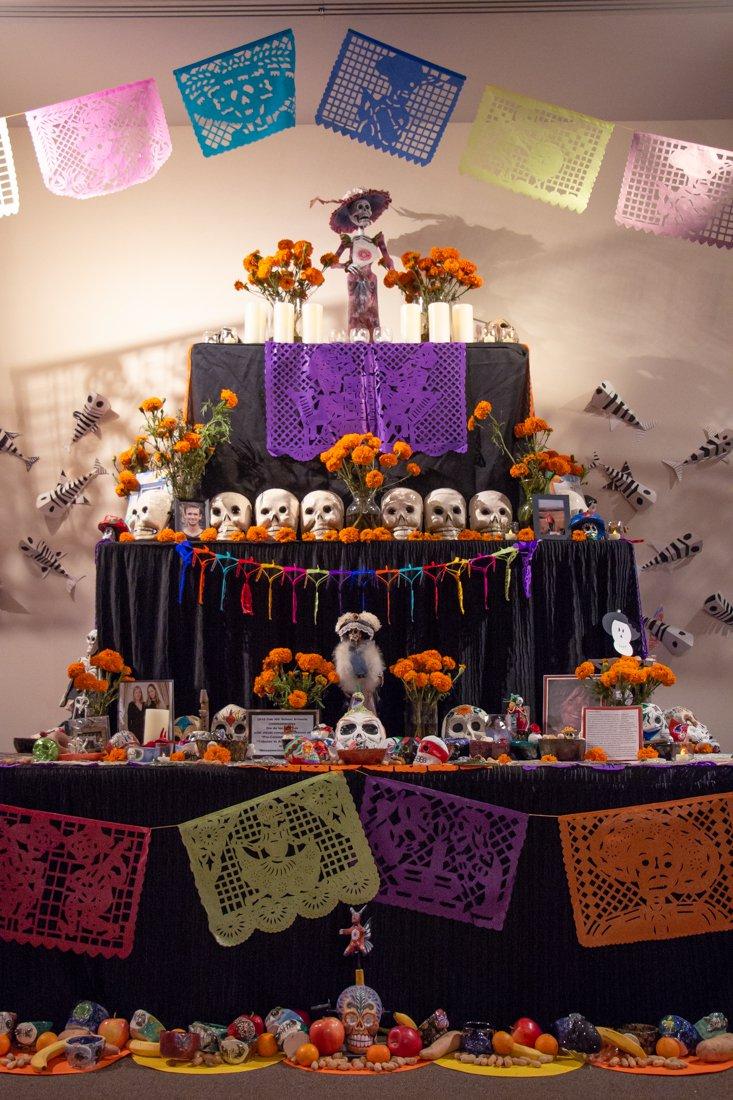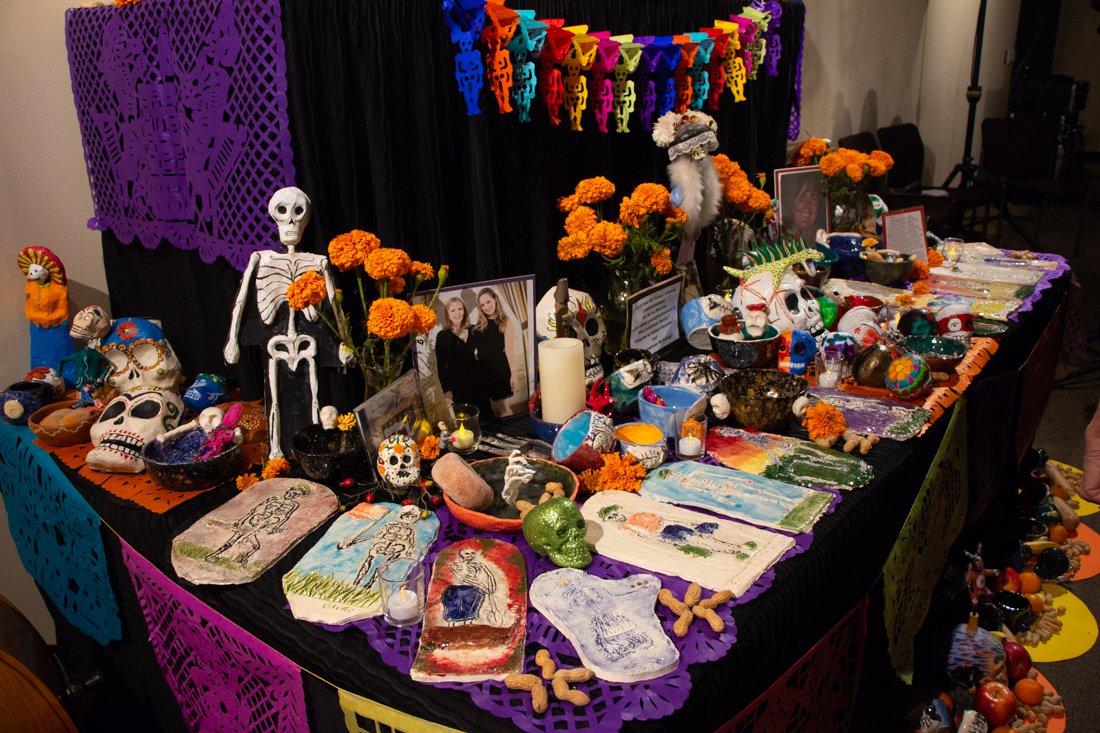Story by Kyra Buckley
Photos by Mason Trinca
[slideshow_deploy id=’20402′]
Today is quite unusual for the students who gather weekly to learn foundations of the Sikh religion at the Gurdwara Sahib Sikh Temple in Salem, Oregon. Surrounding them, the classroom’s cobalt blue walls are covered in yellow papers displaying the children’s efforts in writing the Punjabi language’s alphabet. The students, ranging in age from four to 11 years old, speak quickly and loudly with each other, hardly containing their excitement. Before the day’s festivities begin, teacher Kirandeep Kaur explains a set of rules: Students can converse with their teams before clicking their toy buzzers, but if they buzz in before confirming the answer with their team and they get it wrong, one point will be deducted from their score. Today is Jeopardy day.
Before the game begins, teacher Amandeep Kaur suggests the class participate in a Sikh prayer. Calm fills the room, and for the next few minutes the students recite a morning prayer in the Indian language of Punjabi. Some sit with their hands together and their eyes closed; others have a wandering gaze, yet they are still engaged in the prayer. When they are finished, one female student asks, “Can we start asking Jeopardy questions now?”
When the first question is asked, the students spring to life. Blurting out the answer to a history question, one student is instantly chided for not consulting with her team before answering. One younger boy must be consoled because his team is losing. Another student is reprimanded for buzzing in before a question is read. It’s certainly not a typical game of Jeopardy, but the students appear eager and willing to show off their knowledge of Sikh culture and history.
Sikh, meaning student in Punjabi, is a monotheistic religion that follows the teachings of the ten human gurus. When a teacher asks the name of the eleventh guru during their Jeopardy game, almost every student responds: the Guru Granth Sahib, which is a collection of holy Sikh scriptures regarded as the eternal spiritual guide. Students at the temple are also taught that Sikhism was founded by Guru Nanak approximately 500 years ago in the Punjab region of eastern Pakistan and northern India. Although Sikhism was founded somewhat recently, it is now the world’s fifth largest religion with more than 20 million followers.
Salem’s Gurdwara Sahib Sikh Temple is now the largest Sikh temple in Oregon, but in 1999 when temple president Bahadur Singh moved to Oregon, no such gathering place existed. “[Opening a temple] was pretty much always in my heart,” Bahadur says. “My prayer got listened to.”
Originally from India’s Punjab region, Bahadur moved to San Francisco in 1991. After spending nearly ten years in the golden state, he and his wife moved to Salem. To his knowledge, they were only the second Sikh family living in the area, and it was nearly six years before his prayer to open a temple was answered. In 2005, Bahadur purchased a former Lutheran Church in Southeast Salem and turned it into the temple it is today. When the temple first opened, only five or six families regularly attended—now the congregation consists of more than 100 people who attend the weekly Sunday morning service.
“Our souls are connected here. It doesn’t matter if we are practicing or not,” Bahadur says, referring to the temple. “At least once a week we can bow our heads and bear our life troubles. [God] is not going to tell anybody. You don’t even have to say it out loud. Guru Granth Sahib says that [God] hears your heart. And he does; I know that.”
Founder Guru Nanak’s basic teachings are followed at the temple—the most important of which is treating everyone as equals. According to Bahadur, Guru Nanak’s goal was to create a spiritual community without the rigid class structure of the Hindu-based caste system, which originated about 1,500 years before Sikhism was founded and still exists in India today. Because last name can be an indicator of caste, initiated Sikhs—and often those born into Sikhism—are assigned the last name Singh, meaning lion for men, or for women, Kaur, meaning princess, to promote equality in their communities. Bahadur says equality, truthful living, community service, and emphasis on conscious contact with God, are essential aspects of Sikh lifestyle that are embodied in practices at the temple.
On this day, 11-year-old Amrit Singh, Bahadur’s son, greets guests at the door. He instructs visitors to remove their shoes and wash their hands. Pointing to a basket of blue and orange bandanas, he asks them to cover their heads. Amrit explains that these practices show respect to the Sikh gurus. He also invites visitors to join the langar, a meal offered to anyone who crosses the temple’s threshold.
According to Jasvinder Singh, a 24-year-old junior priest, Sikhs believe that worshipping while hungry diverts attention from God. It is not uncommon for visitors to be offered food many times during their visit to the temple, he says. Women at the temple typically prepare the traditional Indian cuisine offered to guests on any given day. Most orthodox Sikhs do not eat meat; therefore, offerings are always vegetarian. Today’s menu consists of Indian pakora with a spicy cilantro sauce, sweet carrot and sweet almond bars, pita chips, and customary chai tea laid out on a counter in the dining room.
Gold fabric lines the walls of the main room of worship where services begin as a Sikh priest reads from the Guru Granth Sahib. The words are then followed by music and hymn singing. Upon entering the room, Jasvinder says visitors walk across a deep red carpet to where the holy Guru Granth Sahib is kept and bow down, often leaving a small offering. Temple-goers are free to move between rooms during a service—listening to an entire service is not required. Visitors may come and go as they please and participate as much or as little as they like. When a service begins, the room is often almost empty while people getting food at the langar trickle in and out. By the end of a service, the room is filled with families and guests.
Although no formal ceremony is required to be a Sikh, some choose to be initiated, or baptized, into Sikhism and adhere to the religion’s guidelines. Initiated Sikhs, such as Bahadur, have chosen to follow five physical Khalsa practices revealed by the tenth guru, Gobind Singh: kesh, uncut hair that is often covered with a turban; kirpan, a religious sword carried at all times; kara, a thin steel bracelet worn to symbolize eternity; kangha, a comb that is kept in the hair at all times; and kacchera, shorts that are often worn as an undergarment.
While devout Sikhs follow Guru Gobind Singh’s guidelines and wear the five physical markers, others balance fundamental Sikh teachings with individual lifestyle choices. “Sikhism is basically a way of life; it’s a way of being spiritual,” says Ravidas Singh, a lifelong Sikh. “All it comes down to is how to be a good person in your community.”
Ravidas, an international student studying at the University of Oregon, blends the teachings of Sikhism with his everyday life. His family history draws on a mixture of culture from India, Thailand, where he and his parents were born, and Singapore, where his two older sisters were born. Following in his siblings’ footsteps, Ravidas decided to leave Eastern Asia and study abroad. Before moving to Oregon, he expected to live a very traditional and strict Sikh lifestyle, but he quickly learned that to stay true to himself he needed to be more flexible. “A whole lot of emotions went through me, and I was like ‘Okay, what kind of Sikh do I want to be?’” he says.
Throughout his own spiritual searching, Ravidas has kept his upbringing and family heritage in mind. Although he doesn’t always wear his kara, he often carries the thin silver bracelet in his backpack. He does not cut his hair and keeps it wrapped in a white turban, and he also carries a small kirpan. Overall Ravidas is able to follow the basic tenants of Sikhism while adapting to life as an American college student.
Similar to Ravidas, 21-year-old Pawan Kaur balances her Western lifestyle with the traditional Sikh teachings. Also a lifelong Sikh, Pawan was born in California, but at one year old she was sent to live with her grandparents in Punjab, India until she was seven. She is a Sikh by birth, and learned a traditional Sikh lifestyle while living with her grandparents in India. Now she is a student at Portland State University (PSU) and regularly attends services at the Salem Gurdwara Sahib Sikh Temple.
“I cut my hair,” Pawan admits. “I’m not initiated, and I’ve kind of come more into the Western society.” Although she is not an orthodox Sikh, religion still plays an important role in her everyday life—whether she is on the PSU campus, with her friends, or at the Salem temple. “I have a lot of friends who are non-Sikhs,” Pawan says. “How they perceive things and how I perceive things [are different]. It matters a lot to me if I’m doing my work in a pure manner and not cheating my way through it. For school, I would just rather get a bad grade than cheat.”
For temple president Bahadur, part of being a Sikh is adhering to the guidelines set by the tenth Guru and wearing the five markers of the Khalsa.
“I’m baptized, so I have all five things,” he explains. “This is my kara,” he says pointing to his bracelet. “I have my comb here,” he says placing his hand on his head. Next he pulls out a small six-inch dagger-like object, his kirpan. Its small size, he explains, means he can carry it almost anywhere; in India, he adds, some choose to wear a bigger sword. “There is a reason why the Guru gave us these five things,” Bahadur says. “He gave us the comb because he wants us to always be ready, not look or search for anything. He gave us the long shorts so we don’t have to wear another pant or pajama—we could walk around in public,” he says, referring to kachera, the undergarments symbolizing a willingness to go into battle at any time. Pointing to his kara, or bracelet again, he says, “This is saying that I do not do anything wrong with my hand. It reminds us what we stand for.”
Although Pawan, Ravidas, and Bahadur practice Sikhism differently, all agree that a constant awareness of God is the driving force in their lives. Sikhs may use the pronoun “He” to describe God, but their vision of God is a genderless and shapeless form that all humans—whether man or a woman, rich or poor, or a student learning about Sikh history by means of a Jeopardy game—have equal access to. “We believe that God lives within all of us—it’s finding that true light within you,” Pawan says.
Finding the Light Within
Ethos
July 11, 2013
Mason Trinca
Followers of Sikhism strive to balance personal truth with the teachings of the ten gurus.
0
More to Discover







